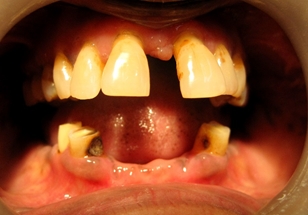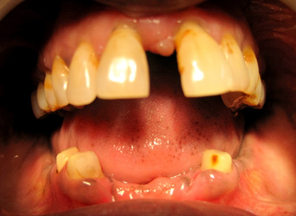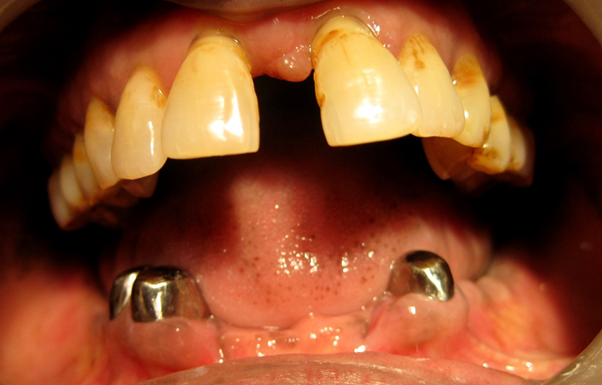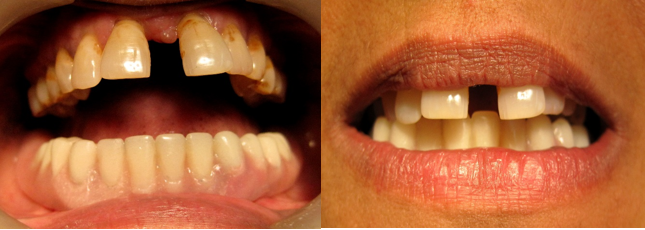Volume : 5 | Issue : 1
Case Report
Tooth supporting overdentures, foundations lasting years of service: A case report
Mohammad Imran Khan,1 Abhisheik Khare,2 Khushboo Arif,3 Sameera Shamim Khan,4
1,2,4Department of Oral and Maxillofacial Pathology and Oral Microbiology, Career Post Graduate Institute of Dental Sciences and Hospital
3Department of Community Dentistry, Career Post Graduate Institute of Dental Sciences and Hospital
Received: December 25, 2022 | Published: December 31, 2022
Abstract
Overdentures are dentures what are built on foundations of natural abutment teeth, most commonly the canines having firm anchorage in the arch and provide excellent support for the functional movements and good retention specially to the mandibular dentures what are difficult to stabilize in resorbed ridges and in cases of patients having poor or restricted muscular movements as in parkinsonism.
Keywords: Overdentures, tooth supported dentures, metal copings
Introduction
Prosthetic dentures what are gaining support and retention from the abutment teeth, are recommended by prosthodontists for preventing and preserving the remaining natural teeth along with providing stability, support and additional retention to the prosthesis, especially in mandibular arch.1 According to Devan, “ Perpetual preservation of what remains is more important than the meticulous replacement.”2 The most important benefits are its cost effectiveness and preservation of periodontium andthe residual alveolar ridge which provides firm stability and retention to the prosthesis. Preventive prosthodontics accentuates the relativity of any planned course of action that can setback or exclude future prosthetic problems thus tooth supported denture is an important part of the preventive treatment process. According Glossary of prosthodontics terms, overdenture is a removable partial or complete denture that covers and rests on one or more remaining natural teeth, roots or dental implants.3 It is also known as overlay denture prosthesis and superimposed prosthesis.
It is essential to preserve natural tooth used as an abutment for construction of overdenture. There must be ample space for roots, metal copings and planned attachments, along with sufficient thickness of the denture base material and prosthetic teeth, all without compromising the structural stability and firmness of the denture.4 Thereby overdentures have excellent support and beneficial in providing psychological, functional and biological benefits to the patients.
The overdentures fulfill three important goals. First it gives the patient a denture which have better support than any other conventional appliance. Secondly it decreases the rate of resorption and thirdly it improves patient’s manipulative skills in handling the dentures through proprioception of the abutment teeth.
All of these factors combined enhance the patient’s prosthetic coordination and ability to learn and train with the denture in his or her physiologic oral muscular movements5.
Li Chen et al (2002) compared the masticatory efficiency of tooth supported overdenture (TSO) patients with complete denture (CD) patients and the results revealed that the TSO provided the greatest degree of efficiency, followed by the CD group.5
Case Report
A 50-year-old female patient reported with chief complaint of missing teeth in its lower arch and wants it to get replaced for good mastication and esthetics. No relevant medical history was given by the patient that can affect the dental treatment. The patient gave a history of loss of her missing teeth over a period of 5 years due to multiple caries and periodontal problems.Extraoral examination presented loss of vertical dimension, unsupported oral tissue musculature. There was minimal of speech articulation. Intraoral examination revealed complete dentulous maxillary arch along with partially edentulous mandibular arch where 33,43 and 44 were the only teeth present with sound periodontal support. (Figure A). rest all of the other teeth were decayed and only root stumps were present which were extracted as per plan for the rehabilitation of the patient.
The various treatment options were available for the patient’s mandibular arch rehabilitation. Patient rejected the options of an implant supported and conventional denture due to longer duration of treatment phase, expensiveness and additional surgery. It was then decided to fabricate tooth supported overdenture with custom made extra-coronal attachment.
Treatment plan
In the mandibular arch right and left canine and right first premolar was present. These teeth had sufficient periodontal support so we decided to retain the remaining lower teeth as abutment and plan a tooth supported over denture. On the first visit, we took pre-operative radiographs, no mobility and periapical pathology was present in the radiographic examination. On her second visit, we completed single sitting root canal treatment of lower canines and right first premolar. (Figure 1a and 1b).
Adequate interocclusal space was available, as all the remaining teeth in lower arch were reduced in height to improve crown – root ratio and the abutment teeth were prepared intra orally with chamfer finish line in the form of dome extending coronally 3-4 mm above the gingival margin to receive metal copings. Impressions were made using light body and cast was poured. The metal crowns were prepared to improve retention form for the denture, and to shield the coronal structure of abutment teeth on the obtained casts, finished and tried in the patient’s arch and were cemented to the abutment teeth in the lower arch. Figure 2
A primary impression of the mandibular arch was made with alginate and a special tray was fabricated on the primary cast after undercuts were blocked out. Using conventional techniques border molding, secondary impression was made with light body rubber base material. Cast was poured in die stone and record rims were made followed by the recording of jaw relations. Establishing an occlusal plane, the wax up, and trying was done on the same day. Teeth arrangement and lab work was finished and tried in patients arch. After a satisfactory try-in, the waxed-up denture was processed using heat cure acrylic.
Mandibular denture has recess areas on the under surface of the denture to accommodate the abutments. Try in dentures were finished, polished and placed into the patient’s mouth. Proper oral hygiene instructions along with practice for removal and insertion of the mandibular denture were given to the patient and the patient was recalled for periodic follow up appointments. Figure 3.
Discussion
One of the most important oral health indicators is the ability to retain a greater number of teeth throughout life.6 An overdenture is defined as a removable prosthesis that encloses the entire occlusal surface of root or implant (Glossary of prosthodontic terms 9).7 Fabrication of tooth supported overdenture is the evident approach in the direction of preventive prosthodontics. One should give importance to proper diagnosis and treatment planning for selection of subjects receiving the prosthesis. Tooth supporting overdenture are recommended in patients with at least few natural teeth present in an arch, patients with misrelated ridges, uncontrolled tongue movements and positions, high palatal arch and muscle attachments which compromises the stability and retention of the overdenture.
Rissin et al (1978)8 found that chewing efficiency of overdenture wearing patients is one -third higher than that of complete denture wearing patients. The keystone of success for an OD treatment is the selection of strategic abutments with endodontic and periodontal therapy to receive the treatment.9
Miller et al (1965)10 found that resorption of alveolar bone depends on multiple factors as composition of bone, overall health of the subject and the amount of trauma to which the oral tissues are subjected to.
Different tooth supported overdenture designs are available including Bar and Clip, Ball and O-ring, ERA and magnetic attachments.9 They provide additional retention and are expensive, so here in this case, we had used metal crowns which are cost effective. Here, abutments are prepared in dome shaped contour and received cast copings. The prepared dentures were directly placed over these prepared abutments, result in providing preservation of alveolar bone, maintenance of proprioception and stability of prosthesis.
The selection of abutment teeth depends on multiple factors as tooth with type 2 or 3 mobility generally are excluded, the circumferential band of attached gingiva is regarded as a mandatory criterion. The location of the abutments is also critical, as mandibular anterior alveolar ridge is most susceptible to time dependent rapid ridge resorption, canines and pre-molars are regarded as best abutments for overdentures as they reduce adverse forces at this site. Same criteria apply to the maxilla as well.
At least one tooth per quadrant as an abutment is supported by clinical experience of many senior prosthodontists. The single rooted teeth are easy to prepare and are cost effective to manage endodontically. In case of pulpal recession to the extent of calcification, endodontic treatment sometimes is avoided.
One frequently encountered problem with over dentures is un-favorable gingival response around the abutment teeth. It may be caused due to undue forces on the abutments because movements are more apparent in mandibular dentures, poor oral hygiene, excessive space in prosthesis around the gingival margins producing dead space acting as potential source of inflammation and hypertrophy of the tissue. Although some minimal space around the gingival margins is good to avoid overloading especially in mandibular dentures as they tend to get displaced more easily than maxillary dentures.11
Instructions for maintenance of oral hygiene has to be explained to the patients and reinforcement of the same has to be done. Recall visit inspection on regular intervals of 5-6 months would maintain the prosthesis, along with periodontal status of the patient at acceptable levels, which provides success to the overdentures.12-14
Conclusion
The prosthetic rehabilitation of partially edentulous arch by an artificial substitute is always a challenge. The concept of overdenture works by delaying the process of complete edentulism and helps in preservation of structure and height of alveolar residual bone. Tooth supported overdenture are an excellent economic therapeutic means providing and supporting patient needs. Even though the preserved teeth may be periodontally compromised, they can still provide adequate support for the transmission of masticatory load and periodontal ligament receptors to initiate jaw reflexes. Multidisciplinary team approach and patient education determine the outcome of treatment and post prosthesis quality of life of patients.
Acknowledgements
None.
Conflicts of Interest
None.
References
- Raja BT Pradeep, PS Manoharan, E Rajkumar. Tooth-supported attachment retained overdenture: forgotten concept revisited-A case report. SRM Journal of Research in Dental Sciences. 2021;12(3):177‒180.
- Drashti Gandhi, Rajesh Sethuraman. Tooth supported Overdenture: Imperative treatment modality: Root to basics. Int J Applied Dent Sci. 2019;5(4):16‒21.
- Samra Rupandeep Kaur, Shreenivas Vasant Bhide, Chhavi Goyal, et al. Tooth supported overdenture: a concept overshadowed but not yet forgotten! Journal of Oral Research and Review. 2015;7(1):16‒21.
- Roy Shubhabrata, Rajesh Khan, Tanmay Biswas, et al. Case Reports on Tooth-Supported Over denture. International Journal of Health Sciences and Research. 2017;7(6):339‒343.
- Sheldon Winkler. Essentials of Complete Dentures Prosthodontics. Second edition, 385‒386.
- Chen Li, Qiufei Xie, Hailan Feng, et al. The masticatory efficiency of mandibular implant-supported overdentures as compared with tooth-supported overdentures and complete dentures. Journal of Oral Implantology. 2002;28(5):238‒243.
- Amruta, Rajeev, Gaurang M, et al. Tooth-supported overdenture: A case report. International Journal of Applied Dental Sciences. 2019;5(3):299‒302.
- Rissin L, House JE, Manly RS, et al. Clinical comparison of masticatory performance and electromyographic activity of patients with complete dentures, overdentures, and natural teeth. J Prosthet Dent. 1978;39:508‒511.
- Chugh Anshul, Malik Sanju, Rani Sunita. Mandibular Tooth-supported Overdenture using Customized Ball Attachments: A Clinical Research. International Journal of Oral Implantology and Clinical Research. 2017;2(3):81‒84.
- Miller PA. Complete dentures supported by natural teeth. Tex Dent J. 1965;83:4‒8.
- Zarb Bolender. Prosthodontic treatment for edentulous patients; twelfth edition. 166‒175.
- Verma PR. Journal of Dental Herald. 2014;1(4):30‒32.
- Potdukhe Shruti, Janani Iyer, Mithilesh Uikey, et al. Attachment Retained Tooth Supported Overdentures: A Case Series. Journal of Clinical & Diagnostic Research. 2022;16(4):1‒4.
- Arunoday Kumar, Rajesh S Nongthombam, Manjula Das, et al. Tooth Supported Overdenture: An Innovative Approach to Manage the Over contouring and encroachment of Inter-Occlusal Distance in a Conventional Tooth Supported Over Denture Prosthesis. IJMBS. 2020;4(6):177‒181.



